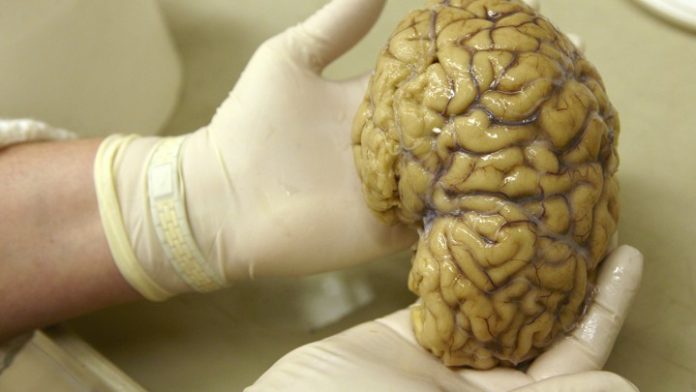The brain doesn’t last long after death. Deprived of blood and oxygen, the organ rapidly deteriorates and eventually shuts down completely.
That process is quick. But quick isn’t the same as immediate. If someone were to jumpstart electrical activity in the hours after death, a brain could maybe—just maybe—be salvaged.
In a study published today in the journal Nature, a team of scientists has taken advantage of that critical window to partially revive the brains of dead pigs after slaughter. The brains didn’t regain the organized connectivity that they’d need for “consciousness,” but some neurons exhibited electrical activity. When coaxed with oxygen and glucose, the organs appeared to gobble them up, and even responded to drugs—clear signs that they had retained some metabolic function.
“This is a real advance,” Andrea Beckel-Mitchener, a neuroscientist at the National Institutes of Health who was not involved in the study, told Gina Kolata at The New York Times. “This has never been done before in a large intact mammalian brain.”
The ethical implications of the research—which has been described as blurring the line between life and death—have already sparked controversy. But scientifically, it presents a strong case for the idea that brain cells aren’t as fragile as previously thought.
Herein lies an important distinction, though: After their owners died, at no point did the brains come back to life. Restoring a subset of brain activity is not enough to constitute full reanimation, or even anything close. “This is not a living brain,” study author Nenad Sestan, a neuroscientist at Yale University, told the press. “This is a cellularly active brain.”
Regardless, “this is a huge breakthrough,” Nita Farahany, an ethicist at Duke Law School who was not involved in the study, told Joel Achenbach at The Washington Post. “Our belief was there’s a point of no return. Certainly we would have believed that four hours after being decapitated, that was a point of no return. It turns out it’s not.”
After sourcing 32 freshly decapitated pig heads from a local pork processing center, a team of researchers led by Sestan extracted the brains. While some were left to deteriorate, others were rejuvenated with a cocktail of nutrients and protective chemicals for six hours. It had only been four hours since the pigs had been slaughtered for their meat, but brain tissue is notoriously fickle and fragile. The goal was to maximize preservation—and, to an extent, it worked.
While some neurons continued their march toward death, others didn’t. Some kept consuming energy; a few even began to fire. But the researchers were unable to detect hints of awareness in any of the brains.
Or, at least, that’s what they think. During the experiment, the brains were infused with the anti-seizure drug lamotrigine, which subdues cellular activity, in the hopes that this would aid the preservation process. The drug could have masked the organized activity that’s often linked to consciousness, but it’s pretty unlikely, the researchers say. Besides, it was never the team’s goal to restore this type of awareness, and, had they seen any signals associated with it, they would have immediately administered anesthesia.
Still, consciousness is hard to define and measure under the best of circumstances—much less in a disembodied pig brain.
As such, the findings raise numerous ethical quandaries, including what this could mean for model organisms used in laboratories, or protocols of human organ transplants, which often rely on donors who have been declared dead and beyond resuscitation.
Any applications of the findings in human patients are a very, very long way off—and this isn’t going to pave the way to human brain transplants, Emory University neuroethicist Karen Rommelfanger, who was not involved in the study, told Ed Yong at The Atlantic. But there are less wild implications, including the advancement of new treatments for conditions ranging from Alzheimer’s to traumatic brain injury.
That’s not to minimize the ethical hurdles that stand in the way. In the meantime, the results of the study “should inform the discussion surrounding brain death,” Kathleen Fenton, a bioethicist and pediatric heart surgeon who was not involved in the study, told Sharon Begley at STAT. “[What] was irreversible appears to not be irreversible…that’s important.”








